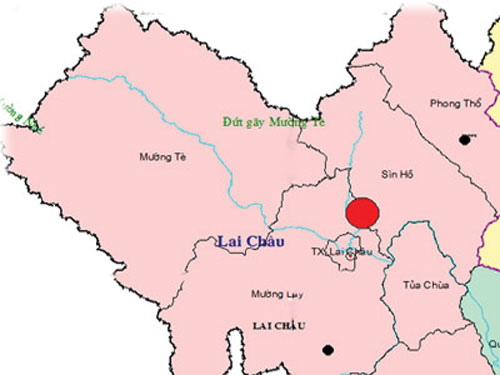Vietnam is facing a high risk of earthquakes
This information was given at the International Conference 'Dangerous Earthquake, Tsunami and Early Warning Systems for Asia-Pacific Region' Institute of Geophysics - Vietnam Academy of Science and Technology organized , with the participation of many scientists from Russia, New Zealand, Indonesia, Italy .
This is an opportunity for scientists in the region to exchange and share experiences to find ways to warn early disasters for the community, to minimize physical and human losses.
According to the report of scientists at the workshop, although not in the 'ring of fire' of strong earthquake episodes in the world, Vietnam still has a high risk of earthquake.

Earthquake epic map at Lai Chau morning 28/4/2011
Historically, there have been some earthquakes with quite strong levels (6.7-6.8 Richter scale) in the fault zones of hundreds of kilometers long, such as Red River and Chay fault zone, Son La, Ma River, fault zone 109.
A number of large urban areas are currently located on the fault zones and there are likely to be earthquakes with very strong levels like Hanoi, lying on the Red, Chay, Ma and Son fault zones. La is expected to suffer from level 8 shocks.
For the tsunami risk in Vietnam, according to scientists from the Institute of Geophysics, earthquakes can cause the most dangerous tsunamis for the coastal areas of Vietnam: earthquakes occur in the Manila submerged zone. The shortest time to spread tsunamis from this zone to the coast of Vietnam is two hours.
The Central Coast region from Dong Ha to Phan Rang is the area most affected by tsunamis in the territory of Vietnam. The northern and southern seas are less likely to be affected by tsunamis.
At the seminar, scientists discussed issues surrounding earthquakes and tsunamis in Vietnam and areas where frequent earthquakes occurred in Japan, New Zealand and Indonesia.
Some international scientists also offer solutions to alert early disasters to the Asia-Pacific region, which is a strategy to cope with the consequences of earthquakes and tsunamis in Vietnam; tsunami scenarios in the South China Sea; methods of determining strong earthquakes and applying them to Southeast Asia; The scenario is based on an assessment of earthquake risk from Italian studies to background effects in Hanoi city.
- Many big cities in Vietnam are at risk of earthquakes
- The risk of tsunami earthquakes affects Vietnam
- Dangerous earthquake in Vietnam
- Vietnam: The tsunami risk is very high
- Why did buildings collapse when the earthquake struck? The truth is more complicated than you think!
- Earthquakes caused many local shakes in Thua Thien Hue
- Pangasius faces an increasing risk of extinction
- Hanoi sensed shaking due to earthquakes in Yunnan, China
- Vietnam is not affected by the Philippine earthquake
- Earthquake due to ... urbanization
- Indonesia earthquake shook Vietnam buildings
- Vietnam coast is very strong erosion!
 Is the magnetic North Pole shift dangerous to humanity?
Is the magnetic North Pole shift dangerous to humanity? Washington legalizes the recycling of human bodies into fertilizer
Washington legalizes the recycling of human bodies into fertilizer Lightning stone - the mysterious guest
Lightning stone - the mysterious guest Stunned by the mysterious sunset, strange appearance
Stunned by the mysterious sunset, strange appearance